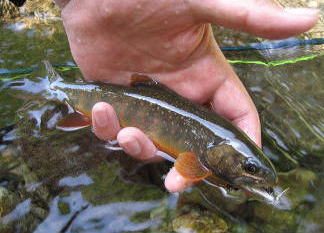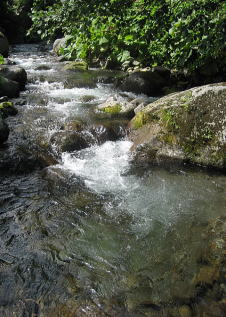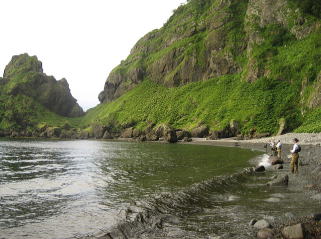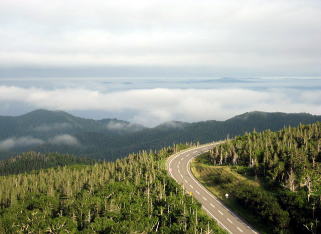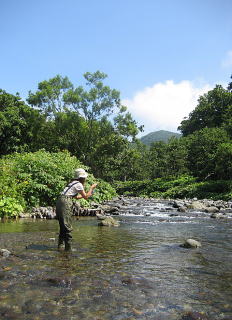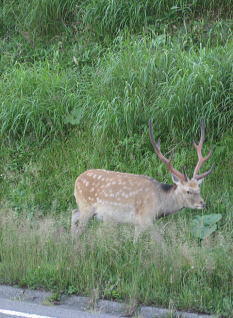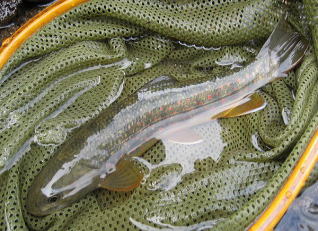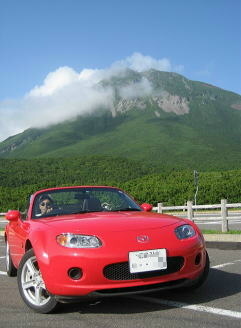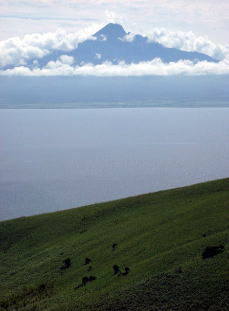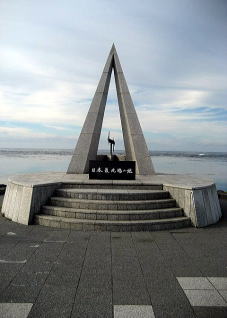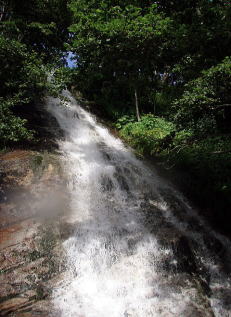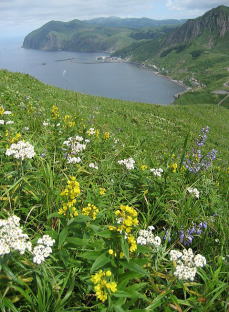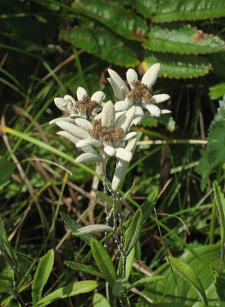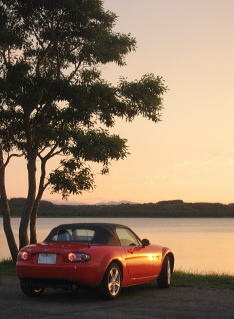A small crown jewel of great Shiretoko.
Mt. Rausu, the tallest peak and the symbol of Shiretoko, as a nice backdrop!
And it's a sanctuary of wildlife. By the roadside you often spot deer,
fox, eagles and occasionally even 'higuma' i.e. grizzly bears!
But our plan was to fish in the pristine Shiretoko streams for 'Oshorokoma'
first.
Rarely exceeding 10 inches, they are the smallest of Char species. Which
is a blessing in disguise, for most of the local anglers ignore these little
chicks altogether.
The island is known for its alpine flowers. There's no tall peaks but the
cool climate offers a perfect habitat for colonies of alpine flowers even
down at the sea level.
June is the best season to admire them, for which we were late. But luckily
enough in a shady corner on the northern slope we found one of the rare
flower, 'Rebun-usuyukisoh', meaning pale snow of Rebun.
For salmon anglers there is a ferry service from the village of Aidomari
that takes you to the tip of the peninsula.
It was two weeks too early as we visited in mid August, and the school
of pink salmon was still some distance off the shore. The dynamic scenery
was worth a visit anyway.
On the eastern side of peninsula spreads the Pacific. Beyond the clouds
washed up on the foot of Shiretoko range, you see the sight of Kunashiri
island, also taken by Soviet now governed by Russia.
Some 300kms drive s. east, we reached the thriving town of Utoro, at the
base of Shiretoko peninsula, which was recently designated as World heritage
site.
We saw a couple of anglers fishing for Karafuto masu, Pink salmon. One
of the guy even hooked one up just as I clicked!
We camped a night by lake Kuccharo, a famous haven of wintering Siberian
swans.
A tiny car but managed to carry enough for our 16days' life on the road
- including a tent, cooking gear, sleeping bags, mats, two pairs of waders,
four pieces of fly rods and other useless toys!
The neighboring island of Rishiri makes quite a contrast with its rugged
volcanic silhouette. The peak at 1,721m above sea is for veteran climbers
only. For us casual trekkers, the distant sight of Mt. Rishiri, wearing
a robe of cloud was enough of a reward.
From Wakkanai, we took a ferry boat to
the island of Rebun a few hours off west.
It is a place of purity and harmony, where we secular creatures are only
temporary guests at best. Okay, we shan't overstay heaven's welcome too
much.
- H'kaido in summer - 3
To make it up we tried another, friendlier location on our way back, dryfly
fishing for Oshorokoma char once again.
It feels funny for us the Southerners, who needs to trek high up in the
mountains before wetting a line, but here in Hokkaido the land of north,
char fishing starts within the sight and sound of the Pacific.
Shiretoko has a dynamic topography. Waterfalls of every size run down the
rocky cliffs to join the rivers, or sometimes drop straight into the sea.
The crisp fresh air is brimming with joy of life.
And it's not only up there in the air.
See here something in the water? Place the pointer on the picture so you
see better!

'06 Hokkaido in summer - 2They are so densely populated and extremely naive, taking anything that passes through their sights - that's what they have to do to survive in the harsh northern environment.
Which makes it all the more important that we fishermen act with care and
discretion. Bulky dry flies tied on #10 barbless hook should help to keep
small fish at a bay.
Returning to the mainland, we drove a short half an hour to Cape Sohya.
Unlike many other noteworthy capes in Japan, this one on the northern tip
of our nation doesn't boast a dramatic set-up. We only saw a lazy school
of saltwater barbels right at its foot.
